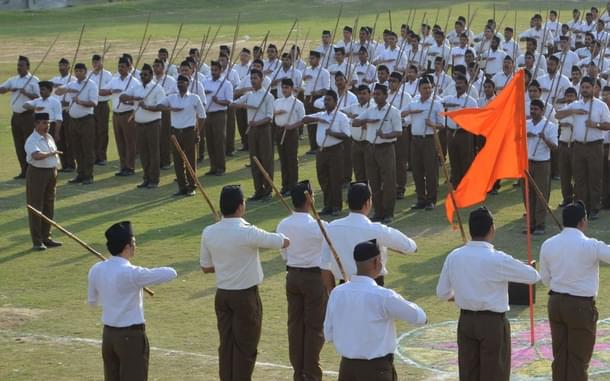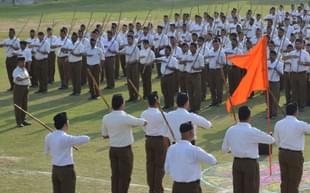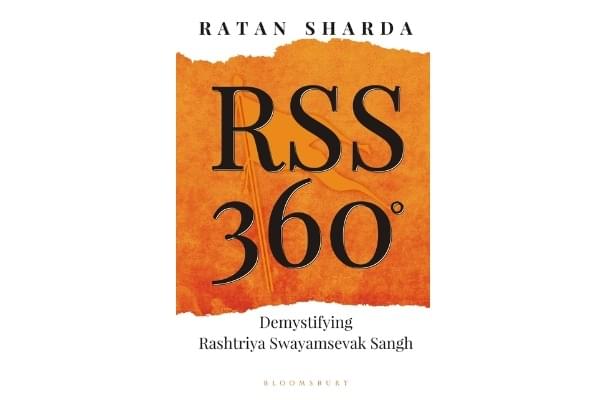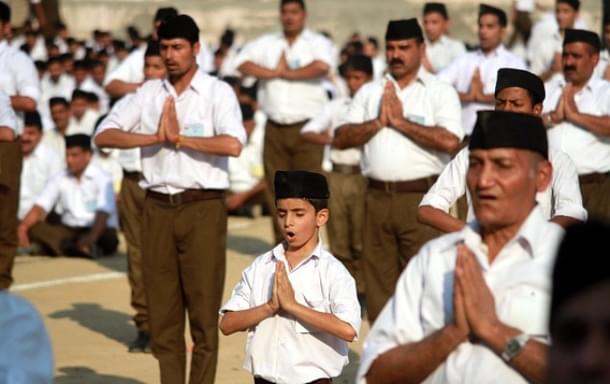Politics
The RSS You Do Not Know: An Insider’s Tale On What Drives Sangh’s Success
R Jagannathan
Jun 28, 2018, 11:35 AM | Updated 11:35 AM IST
Save & read from anywhere!
Bookmark stories for easy access on any device or the Swarajya app.


Ratan Sharda. RSS 360: Demystifying Rashtriya Swayamsevak Sangh. Bloomsbury. 2018.
One of the things journalists ought to do is to understand something before they decide to criticise it. As organisations go, the Rashtriya Swayamsevak Sangh (RSS) has been more reviled in the media than understood. It has been around for 94 years, and from the time of Nehru to today’s “intolerant” times, it has remained in the doghouse of public opinion even as the organisation has gone from strength to strength.
This paradox cannot be explained without actually looking at the innards of the organisation, which has survived three bans from birth to today. The Lindy effect, popularised by Nassim Nicholas Taleb (author of Black Swan, Antifragile and Skin in The Game) in recent years, suggests that the length of an idea’s survival is a good predictor of its future survival probabilities. There are no two ways about it. Despite the regular roasting it gets from critics motivated more by bias and bile, the RSS is here to stay. We might as well get our arms around it.
It’s not that the RSS has not been studied and researched before. From unfriendly and over-opinionated writers like Christophe Jaffrelot, who wrote The Hindu Nationalist Movement and Indian Politics (he belongs to the awards wapsi school of thought) to more nuanced authors like Walter Anderson (The Brotherhood in Saffron), we have had some good external insights. An insider’s critique by Sanjeev Kelkar (RSS: The Lost Years), who parted ways with his organisation, shines a useful torch on the organisation and its challenges. We now need to add Ratan Sharda’s RSS 360: Demystifying Rashtriya Swayamsevak Sangh (Bloomsbury, 2018) to the list, and it is probably going to be an eye-opener to mindless critics, assuming they bother to read it. Sharda is an insider who is not unaware of the criticisms – some of which he accepts - levelled against the organisation he has been part of for decades. Hence the added value of this book. He is fairly convincing in underlining that the RSS is a force for good, despite its real and mythical shortcomings.
One reason why the RSS gets more bad press than good is because its leaders and workers, from the Sarsanghchalak at the apex to the humble swayamsevak at the grassroots, lead humble lives and usually shun publicity. Thus, while the murderous Naxals often get a good press from Urban Naxals like Arundhati Roy (she called them Gandhi, but with Guns), few are willing to dub the Sangh as Gandhi, but in Shorts, thanks to the bum rap they received from Nehru and the Left cabal for allegedly being part of the plot to kill Gandhi in 1948. The RSS has, by and large, turned the other cheek and continues to live with this calumny, going about its business with a sense of pure dedication. This media-aversion has actually helped the organisation focus on its core task of character-building and nation-building without having to pander to the Lutyens mob, but it has also created a sense of mystery – bordering on the sinister - around the organisation. Ratan Sharda’s book is an attempt to remedy this, though the book is not necessarily blessed by the RSS. If you are willing to suspend your suspicions for the few hours you may spend reading the book, if you are willing to keep your biases aside for a while, it will be a rewarding exercise.

Sharda, who has risen from the ranks (that is the only way swayamsevaks rise) and held senior positions in the organisation, begins the Sangh story from the middle of its timeline – from the 1975 internal emergency, when Indira Gandhi threw nearly 1,30,000 people in jail to squash any opposition to her undemocratic rule – rather than from the time of its birth under Keshav Baliram Hedgewar in 1925. Surprise: more than two-thirds of those arrested were RSS karyakartas and pracharaks, who were organising themselves to oppose this tyranny.
It may be a good start for the book, since it shows the RSS not as a defender of fascism, as its critics regularly allege, but an opponent of it. However, what works as a good starting point for dispelling a myth about the organisation may not be a good starting point for the skeptics. You want to know the “inside” story of how the Sangh is organised, how it “indoctrinates” its people, the sources of its funding, etc. So, if you are an RSS critic or disbeliever, I would suggest that you too should follow Sharda’s example, and start the book from the middle chapters. If you like what you read, the beginning (which critiques the critics and lays out the organisation’s worldview) may make more sense; if not, you can skip what you may dismiss as propaganda.
The core of the book, the RSS secrets you may really want to know, begins from page 91, which starts with a full rendition of the daily RSS prayer offering salutations to the motherland and promising to serve it selflessly (Namaste sadaa vatsale matrubhoomi, meaning, I bow to thee, O loving motherland). The prayer is all about volunteering to work for the country, with not one word of negativity against anyone. It’s the Sangh’s version of the Gita’s “Nish kaama karma” (action without desiring the fruits of action). Every swayamsevak is told the meaning of this prayer repeatedly, and the spirit of sacrifice and service is emphasised all the time. There is no place for ego in the Sangh, just selfless work and devotion.
Chapters 6 and 8 are important, for the former describes what is done at the shakha level and why it is key to the Sangh project of nation-building through individual character-building, and the latter its overarching mission. If you understand these two ideas, you will know what the Sangh is all about, and why it does, or does not do, things that one would normally associate with an organisation meant to build Hindu unity.
The numbers presented by Sharda are staggering, though not entirely unknown. There are apparently 56,000 shakhas, where daily attendance for an hour involves half a million people. Adding those who may not attend the shakha daily, the author estimates that 5.6 million people are directly involved with the Sangh emotionally. This bit of statistics should explain why all political parties are both envious and fearful of the Sangh, for when this power is projected into politics, it can threaten most leaders. Perhaps, this was what made Nehru ban the RSS in 1948 after Gandhi’s assassination, wrongly blaming the Sangh for this heinous act. The RSS faced two more bans in its life, once in 1975 during Indira Gandhi’s internal emergency, and again during the Ram Janmabhoomi agitation that resulted in the demolition of the Babri structure in 1992. The RSS’s interest in the BJP comes primarily from the need to get itself political cover, given the repeated attempts by political enemies to rob it of its legitimacy.
The main fare dished out at the shakha, where average numbers could be around 100 persons, is a mix of Indic games, physical drills, yoga, prayer, and some mild intellectual discussions. The mix may vary at some shakhas, but the core idea is to drill the ideas of humility, service and commitment to build unity above all else. No new member is ever asked for details about his caste or faith, though, given the huge propaganda against the Sangh, few Muslims or Christians dare to take an independent line and check it out for themselves. Daily shakhas last for about an hour, encompassing the RSS idea that everyone must give at least one hour a day to his country. A key lesson often given in shakhas is this one: however glorious our Hindu civilisation, it was done in by a lack of unity, thus enabling enemies to defeat them easily. This forms the basis of the RSS’ stress on unity and discipline over discord and difference. On the obverse side, proponents of diversity may wonder whether the RSS is trying to unify Indians by creating an Abrahamic monoculture, but the critics should also ask themselves whether they are celebrating difference or disunity.
A surprising fact: despite all the Hindu unity talk, and despite all the allegations of Brahminical thinking heaped on them, few RSS members are religious in the traditional sense of the term. In Sharda’s words: “Though nearly all RSS volunteers are religious and spiritual, I doubt if most of them perform regular rituals that go with visible Hindu practices. There is no training at all (in shakhas) about Hindu rituals and practices or (efforts to) influence…the so-called Brahminical samskaras.” This lack of enthusiasm for popular Hindu ritualism perhaps goes back to the Sangh’s more charismatic second chief, MS Golwalkar, who, Sharda says, “would admonish people that putting tilak on the forehead, reciting shlokas or scriptures blindly and garlanding one’s god is not true religiosity or spiritualism. For him, patriotism, surrender of self for motherland and service to fellow human beings were the highest form of spiritualism.”

This is probably a chink in the organisation’s kavach, for it makes it easy for the Sangh’s enemies to separate Hinduism from Hindutva. The Sangh should consider how this can be addressed.
The other chapters presented in the middle of the book talk about the key values and sense of devotion to the nation inculcated in volunteers from an early stage, the Sangh’s overarching Mission (chapter 8), the training of present and future leaders of the Sangh, the organisational structure, the institution of the pracharak (who is usually a brahmachari, primarily because his life has to be dedicated to the nation, and those with families cannot give that kind of time), etc.
Chapter 7 is interesting, for it tells us which Hindu ideas and festivals the RSS emphasises, and why popular festivals like Diwali or Holi do not make the cut. The Sangh’s key festivals are the New Year (Varsh Pratipadaa), usually around mid-April, Hindu Saamrajya Din, which is the day Shivaji was crowned king and not the same as Shivaji Jayanti (his birthdate), Guru poojan, Raksha Bandhan (which, again, is not the traditional celebration of the brother-sister relationship, but about universal brotherhood and the Sangh’s idea that the strong must protect the weak), Vijayadashami (when the RSS chief gives out his annual message to swayamsevaks), and Makar Sankranti (which coincides with harvest festivals, and the renewal of activity in every sphere). Put simply, the RSS aligns some Indian and Hindu cultural practices to its own ideology, by reinterpreting them differently. This could be another lever presented to critics to drive a wedge between traditional Hindus and the Sangh.
Chapter 8, which deals with the mission of the Sangh, explains why the Sangh has overcome every challenge thrown at it so far: it has always put its mission above the individual. The organisation’s leaders may come and go, you can imprison them or eliminate them, but the mission will continue since the Sangh is not driven by individuals. Swayamsevaks are constantly told that the mission is not a side-business, something to be done part-time, but ought to be their primary goal. This also explains why the Sangh does not ever need to raise money from sponsors. The Sangh’s funds come from its own volunteers, and it is offered as Guru Dakshina on Guru Poornima Day in unmarked envelopes. When there are no external sponsors trying to tell the Sangh what to do, and every swayamsevak is directly invested, both emotionally and monetarily, in his organisation, who can sink the ship?
These attributes of the Sangh go some way in explaining how its has produced a Prime Minister who spends 18 hours a day focusing on work, almost without a break. But the idea - that volunteers exist for the organisation to do its duty, and not vice-versa - also throws up an inherent weakness of the BJP-RSS style of functioning: a marked reluctance to create a Congress-type patronage culture that could have created a rival ecosystem to take on the shrill and entrenched Congress-Left one. Modi is seldom known to reward people who helped the party come to power, and while this eliminates self-seekers from joining the bandwagon, it also alienates a segment of the support base which may like some of the benefits of office.
The third part of the book discusses the Sangh’s offshoots. Not all of them are front organisations; they are often only outfits where the Sangh may have lent talented leaders from its own growing pool. It should thus come as a surprise that the Jana Sangh, the previous avatar of the Bharatiya Janata Party, was not a party floated by the RSS, but merely a party started by former Hindu Mahasabha leader Syama Prasad Mookerjee, who wanted the RSS to lend him some good men, among whom a young pracharak called Deendayal Upadhyaya was the most influential in the party’s early days.
The major offshoots, which are considered sister organisations or associates of the Sangh, but not subsidiaries, include the Akhil Bharatiya Vidyarthi Parishad (which focuses on campuses), the Bharatiya Mazdoor Sangh (India’s biggest trade union), the Vanvasi Kalyan Ashram (a tribal uplift arm focused on countering missionary activity in the tribal belts), the Saraswati Shishu Mandir (which runs 27,000 schools) and Ekal Vidyalayas (one-teacher schools for distant communities), the Vishwa Hindu Parishad (which needs no introduction), and Samskrita Bharati (which focuses on popularising spoken Sanskrit through an improvised teaching method).
Outfits which the Sangh is not to happy with, or happy to disown, include the Bajrang Dal, the Sri Ram Sene, and some fringe groups that indulge in mindless thuggery. Sharda also seems to suggest that the Swadeshi Jagran Manch (SJM) is not exactly the apple of the Sangh’s eye.
Sharda has done us a favour by writing this book, which is an expansion of his earlier tome titled Secrets of the RSS. It could have done with some better editing and proofing, but its real value is in the message, not the occasional mistakes in English. The Sangh is not guardian of the Queen’s English.
Jagannathan is former Editorial Director, Swarajya. He tweets at @TheJaggi.




